
JOURNAL OF OPERATOR THEORY
Scope & Guideline
Pioneering Research in the Realm of Operator Theory
Introduction
Aims and Scopes
- Operator Algebras:
The journal emphasizes research on operator algebras, particularly C*-algebras and von Neumann algebras, exploring their structure, representations, and applications in functional analysis. - Functional Analysis:
It covers various aspects of functional analysis, including bounded operators, spectral theory, and the interplay between operators and functional spaces. - Noncommutative Geometry:
The journal includes studies on noncommutative geometry, investigating the geometric aspects of operator theory and their implications in physics and mathematics. - Operator Theory Applications:
Research that applies operator theory to other fields, such as quantum mechanics, signal processing, and other areas of mathematics, is a significant focus of the journal. - Matrix Theory and Linear Operators:
The journal features papers that delve into the properties of matrices and linear operators, including their behaviors, transformations, and applications in various mathematical problems.
Trending and Emerging
- Quantum Groups and Noncommutative Structures:
Recent publications highlight an increasing interest in quantum groups and noncommutative structures, reflecting the growing intersection of operator theory with quantum mechanics and mathematical physics. - Graph Theory and Operators:
There is a rising trend in the exploration of operator theory in relation to graph theory, examining how operators can be analyzed through the lens of graph structures and properties. - Operator Dynamics and Ergodic Theory:
Research focusing on operator dynamics, including ergodic theory applications, has gained momentum, indicating a broader interest in understanding the long-term behavior of operators. - Advanced Operator Algebra Techniques:
Papers employing advanced techniques in operator algebras, such as the investigation of crossed products and modular properties, are increasingly prevalent, demonstrating a shift towards more sophisticated mathematical tools. - Applications to Mathematical Physics:
The journal is witnessing a growing number of articles linking operator theory with mathematical physics, particularly in areas such as quantum field theory and statistical mechanics, showcasing the relevance of operator theory in contemporary scientific inquiries.
Declining or Waning
- Classical Spectral Theory:
There has been a noticeable decrease in the number of papers focusing on traditional spectral theory, which historically examined the eigenvalues and eigenvectors of operators in a more classical framework. - Basic Operator Theory:
Papers addressing foundational aspects of operator theory without advanced applications or specific contexts appear to be less frequent, indicating a shift towards more specialized and applied research. - Elementary Functional Analysis:
Topics that cover basic functional analysis concepts, such as introductory discussions on Banach and Hilbert spaces, are observed to be diminishing as researchers delve into more complex interrelations and applications.
Similar Journals
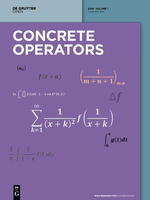
Concrete Operators
Unveiling New Dimensions in Mathematical ResearchConcrete Operators is an innovative academic journal published by DE GRUYTER POLAND SP Z O O, specializing in the fields of Analysis and Applied Mathematics. With an ISSN of 2299-3282, this open access journal has been dedicated to fostering scholarly communication since its inception in 2013. Concrete Operators aims to provide a platform for researchers, professionals, and students to explore and disseminate significant findings in mathematical analysis and its practical applications. Housed in Germany, with administrative offices located in Warsaw, Poland, the journal embraces a global audience. Notably, as of 2023, it holds a Q4 category ranking in the respective mathematical domains, reflecting its commitment to emerging research within the community. The journal's open access model enhances visibility and accessibility, encouraging collaboration and innovation among mathematicians. By bridging theoretical advances with practical implementations, Concrete Operators plays a vital role in the advancement of mathematical sciences.

Advances in Operator Theory
Pioneering Research in the Realm of MathematicsAdvances in Operator Theory is a premier journal dedicated to the exploration of innovative and foundational research within the disciplines of Algebra and Number Theory, as well as Analysis. Published by SPRINGER BASEL AG, this journal provides a vital platform for the dissemination of high-quality research and theoretical advancements in the realm of operator theory. With a commendable impact factor and categorized in the Q3 quartile for both Algebra and Number Theory and Analysis in 2023, it holds significant standing in the Scopus rankings, substantiating its relevance in the mathematical community. The journal encourages open discussions and lively exchange of ideas among researchers, professionals, and students alike, fostering an environment conducive to scholarly growth and collaboration. Based in Iran at PICASSOPLATZ 4, BASEL 4052, SWITZERLAND, it has been actively publishing since 2016, making substantial contributions to its field through rigorous peer-reviewed articles. As an essential resource for anyone invested in the forefront of mathematical research, Advances in Operator Theory continues to illuminate complex topics and inspire future inquiries.
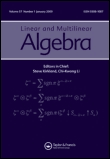
LINEAR & MULTILINEAR ALGEBRA
Unlocking New Dimensions in Algebraic StudiesLINEAR & MULTILINEAR ALGEBRA, published by Taylor & Francis Ltd, is a distinguished academic journal that has been contributing to the field of mathematics since 1973. With an ISSN of 0308-1087 and an E-ISSN of 1563-5139, this journal focuses on innovative research in algebra and number theory, reinforcing its standing as a vital resource for mathematicians worldwide. Currently ranked in the Q2 quartile of its category, and holding an impressive rank of 13 out of 119 in Scopus, it occupies a prominent position in the field, commanding a significant 89th percentile. The journal aims to disseminate groundbreaking research, critical reviews, and theoretical advancements, making it an essential platform for both established researchers and emerging scholars. With a publishing horizon stretching to 2024, LINEAR & MULTILINEAR ALGEBRA is poised to continually influence the mathematical community while fostering a deeper understanding of linear and multilinear frameworks.
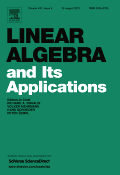
LINEAR ALGEBRA AND ITS APPLICATIONS
Connecting Mathematical Theory with Real-World ApplicationsLINEAR ALGEBRA AND ITS APPLICATIONS, published by Elsevier Science Inc, is a prestigious journal that serves as a vital resource in the field of mathematics, specifically focusing on the areas of linear algebra and its myriad applications across various disciplines. Since its inception in 1968, this journal has established a solid reputation, achieving an impressive impact factor that places it in the Q1 category for Algebra and Number Theory as well as for Discrete Mathematics and Combinatorics in 2023, showcasing its significant contribution to these fields. The journal's rigorous peer-review process ensures that published works reflect the highest standards of scholarly research, further establishing it as a leading publication for mathematicians and researchers alike. Although it does not currently offer Open Access options, its wide-reaching audience can access invaluable findings and innovations within its pages. With a commitment to advancing knowledge and fostering innovation, LINEAR ALGEBRA AND ITS APPLICATIONS continues to be an essential platform for disseminating impactful research that shapes the future of mathematics.
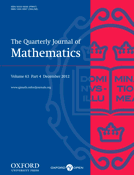
QUARTERLY JOURNAL OF MATHEMATICS
Illuminating the Path of Mathematical DiscoveryQuarterly Journal of Mathematics, published by Oxford University Press, stands as a pivotal resource for the mathematical community, focusing on a broad spectrum of topics in the field of mathematics. With its esteemed history dating back to 1930, this journal continues to foster innovative research and discussions, providing a platform for scholars to share their findings and insights. Although the journal currently holds a Q3 classification in mathematics (miscellaneous) and is ranked #207 among general mathematics publications in the Scopus database, its commitment to quality and rigorous peer review ensures that it remains relevant and insightful. Researchers, professionals, and students alike will find the Quarterly Journal of Mathematics an invaluable tool for advancing knowledge and understanding in various mathematical disciplines, making it an essential addition to any academic library.

Operators and Matrices
Bridging Ideas and Methodologies in Advanced MathematicsOperators and Matrices is a distinguished academic journal dedicated to the fields of algebra, number theory, and analysis, published by ELEMENT. Operating from Croatia since its inception in 2009, this journal provides a vital platform for groundbreaking research, aiming to foster advancements in mathematics through the publication of high-quality articles. With an ISSN of 1846-3886, it has secured a respectable Q3 category ranking in both the Algebra and Number Theory and Analysis categories according to the latest metrics. Current Scopus rankings position it at #83/119 in Algebra and Number Theory and #153/193 in Analysis, indicating its growing influence in the academic community. Although it does not provide open access, the journal strives to promote a robust exchange of ideas and methodologies that illuminate complex mathematical concepts, thereby appealing to researchers, professionals, and students alike. By contributing to Operators and Matrices, scholars can place their work within a significant context, advancing their professional footprint in the mathematical landscape.

REVIEWS IN MATHEMATICAL PHYSICS
Exploring the Frontiers of Mathematical PhysicsREVIEWS IN MATHEMATICAL PHYSICS is a premier scholarly journal published by WORLD SCIENTIFIC PUBL CO PTE LTD, focusing on the versatile and dynamic field of mathematical physics. Established in 1996, this journal has quickly become a pivotal resource for researchers and professionals seeking in-depth analyses and reviews of contemporary advancements in both mathematical and statistical physics. With an impressive categorization in Q2 for both Mathematical Physics and Statistical and Nonlinear Physics as of 2023, it ranks among the top in its field, boasting a Scopus Rank of #27 in Mathematical Physics and #29 in Statistical and Nonlinear Physics. While currently not available as an open-access platform, the journal remains valuable for its rigorous peer-reviewed articles that aim to bridge the gap between theoretical aspects and practical applications in physics. Given its significant influence—evidenced by a robust footprint in the academic community—REVIEWS IN MATHEMATICAL PHYSICS is essential reading for anyone dedicated to advancing their knowledge and understanding of complex physical phenomena.
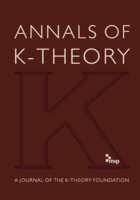
Annals of K-Theory
Shaping the Future of Mathematical Research and CollaborationAnnals of K-Theory, published by Mathematical Science Publishers, is an esteemed academic journal that serves as a vital platform for advancing research in the fields of analysis, geometry, and topology. Since its inception in 2016, the journal has successfully merged rigorous mathematical exploration with practical application, catering to a diverse audience of researchers, professionals, and students. With an impressive track record as a Q2 journal in Analysis and Geometry and Topology, and achieving a Q1 ranking in Assessment and Diagnosis in 2023, Annals of K-Theory continues to be recognized for its significant contributions to the mathematical sciences community. Although currently not open access, the journal provides relevant and accessible content that encourages rigorous dialogue and collaboration among mathematicians. As indicated by its Scopus rankings, it holds a commendable position within its field, demonstrating a commitment to quality research that pushes the boundaries of mathematical knowledge and application.

Pure and Applied Mathematics Quarterly
Connecting Mathematicians Through Quality ResearchPure and Applied Mathematics Quarterly is a prestigious journal published by INT PRESS BOSTON, INC, focusing on the diverse and evolving field of mathematics. Since its inception in 2007, this journal has grown significantly, currently holding a Q1 ranking in the Mathematics (Miscellaneous) category for 2023, positioning it among the leading publications in the discipline. With a commitment to publishing high-quality research, Pure and Applied Mathematics Quarterly fosters innovation and dialogue within the mathematical community by providing a platform for theoretical advancements and practical applications. The journal remains accessible to researchers and professionals through its ISSN 1558-8599 and E-ISSN 1558-8602, although it does not currently offer open access. As a vital resource for mathematicians, educators, and students, this journal endeavors to expand the frontiers of mathematical knowledge and contribute to the academic dialogue surrounding this fundamental science.

Complex Analysis and Operator Theory
Elevating Mathematical Discourse and DiscoveryComplex Analysis and Operator Theory, published by Springer Basel AG, is a renowned journal in the field of applied and computational mathematics, reflecting a strong engagement with contemporary mathematical challenges. With an ISSN of 1661-8254 and E-ISSN 1661-8262, this journal provides a platform for disseminating significant findings and innovative methodologies that contribute to the advancement of complex analysis, operator theory, and their diverse applications. As a valuable resource for researchers and practitioners alike, it features high-quality peer-reviewed articles that rigorously explore both theoretical and practical aspects of mathematics. Although it currently does not offer open access, readers can access its insightful content through institutional subscriptions or individual purchases. Since its inception in 2007, the journal has carved a niche for itself, evidenced by its placement in the Q2 quartiles in both Applied Mathematics and Computational Mathematics, and its recognition in Computational Theory and Mathematics. With an ambitious goal to foster the dialogue between theory and practice, Complex Analysis and Operator Theory continues to support the mathematical community from its base in Basel, Switzerland.